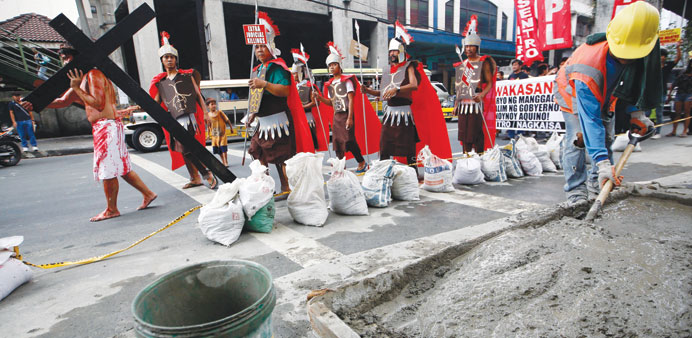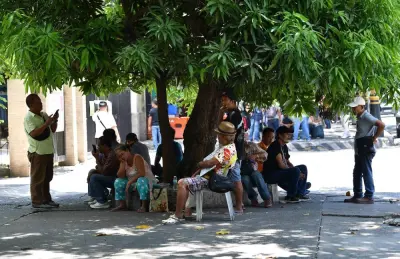DPA/San Pedro Cutud
For the past decade, Audi Gabriel has been the lone man nailing penitents during Good Friday crucifixions that draw thousands to a northern Philippine village.
Other villagers have shunned the job after several people who had performed the task for years suffered sudden death or became paralysed, according to the 57-year-old Gabriel.
“People were afraid, but I took on the job to keep the tradition going,” he said as he tended his neighbourhood store in front of his house in the farming village of San Pedro Cutud, in Pampanga province, 70 kilometres north of Manila.
“Whether I like it or not, I will die anyway,” he said. “We all die in the end. This is my penance.”
The retired carpenter and grandfather of two said he still gets nervous about pounding nails into the palms and feet of the Kristos, the men who get crucified every Good Friday in San Pedro Cutud.
“My hands still shake at the start,” he said, “but I just concentrate and ask God to guide me.”
Every year, thousands of foreign and local visitors flock to San Pedro Cutud to watch hooded and barefoot penitents lash their backs bloody along a narrow road that leads to a dusty hillock, where other men dressed as Jesus Christ are nailed to wooden crosses.
The dramatisation began in 1955, but only in 1962 was a man first actually nailed to a cross in San Pedro Cutud. The original Kristo was Artemio Anoza, a self-described faith healer who offered the act as a sacrifice for more healing power.
Since then, more penitents have volunteered to be crucified. Each year, no fewer than 10 men and occasionally some women have been nailed to the cross in San Pedro Cutud.
The Catholic Church disapproves of the gory rituals and warns that such fanatical expression of faith could actually take away from the real meaning of Lent.
Despite the pageantry and criticisms, the villagers of San Pedro Cutud are holding on to the tradition with the same religious fervour that their forefathers had when they began the practice to atone for their sins, seek wishes or give thanks.
“Good Friday is the most important day for our village,” said June Canlas David, a councillor at San Pedro Cutud. “It is when we fulfil our religious vows, which we inherited from our ancestors. This tradition is very important to our lives.”
“Everyone takes their duties very seriously and even spend their own money to help others do their penitence,” he said.
The 48-year-old father of two began to flog himself with whips fitted with bamboo sticks during Holy Week when he was 17-years-old, taking over the duty of keeping the tradition alive in his family from his father.
He did it for 24 years before stopping and becoming a bleeder, or one who cuts the back of penitents to make sure that blood flows when they hit themselves.
“Without the bleeders, the penitents won’t be able to do their penance,” he said, showing the tool he uses to cut the back of floggers -- a wood paddle fitted with nine glass shards.
The re-enactment starts with Roman guards dressed in red uniforms and gold helmets arresting the lead Kristo, and dragging him before Pontius Pilate for sentencing.
The Kristo is then scourged and made to carry a wooden cross in a 500-metre procession under the blistering sun. Other penitents follow behind, carrying their own crosses, whipping their backs or crawling on the road.
Ruben Enaje Jr, who has played the lead role of Jesus Christ for the past 27 years, said the reward for his penance has been worth the pain and sacrifice.
“Every year, the pain becomes worse,” he said, while taking a break from painting T-shirts with the face of Jesus Christ that will be given to participants in the Good Friday procession.
“But this is my vow so I will continue until there is a new Kristo who can take over my role,” he said, rubbing his palms where 7.5-centimetre stainless steel nails are pounded every year.
The 53-year-old former building painter said his life has improved since he volunteered for the crucifixions in 1986, as a thanksgiving after he fell from a scaffold on the job but was unhurt.
He later offered the penance for the quick recovery of his son and wife who became gravely ill.
“My hands are my key investments in my work and even though I am crucified every year, they are as steady as ever,” he said.
“Now I have my own business, I have a car and we have a good life.”
Enaje said he also offers his penance for other people who seek help. “When I was buying paint the other day, a man recognised me and asked me to include him in my prayers,” he said. “Along the way to the crucifixion, people would call out to me, Christ, pray for us!
“I look at them and remember their faces. When I’m on the cross, I send those faces to God for his help.”

Filipino protesters re-enact the crucifixion of Christ during a rally near Malacanang Presidential Palace in Manila yesterday. Filipino protesters sta


